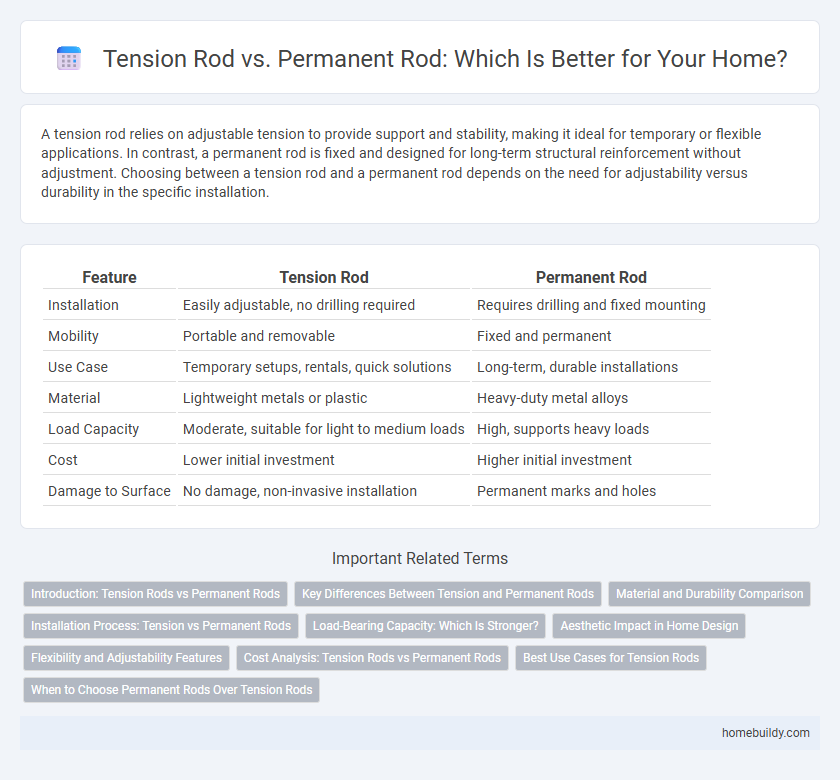A tension rod relies on adjustable tension to provide support and stability, making it ideal for temporary or flexible applications. In contrast, a permanent rod is fixed and designed for long-term structural reinforcement without adjustment. Choosing between a tension rod and a permanent rod depends on the need for adjustability versus durability in the specific installation.
Table of Comparison
| Feature | Tension Rod | Permanent Rod |
|---|---|---|
| Installation | Easily adjustable, no drilling required | Requires drilling and fixed mounting |
| Mobility | Portable and removable | Fixed and permanent |
| Use Case | Temporary setups, rentals, quick solutions | Long-term, durable installations |
| Material | Lightweight metals or plastic | Heavy-duty metal alloys |
| Load Capacity | Moderate, suitable for light to medium loads | High, supports heavy loads |
| Cost | Lower initial investment | Higher initial investment |
| Damage to Surface | No damage, non-invasive installation | Permanent marks and holes |
Introduction: Tension Rods vs Permanent Rods
Tension rods provide adjustable stability by applying controlled pressure between two surfaces, making them ideal for temporary or flexible support in construction and interior design. Permanent rods are fixed solutions, offering long-term structural reinforcement without the need for adjustments once installed. Selecting between tension rods and permanent rods depends on the requirement for adjustability and the intended duration of use in the application.
Key Differences Between Tension and Permanent Rods
Tension rods are adjustable components designed to withstand tensile forces, commonly used in scaffolding and construction for temporary support and alignment, while permanent rods serve as fixed, load-bearing elements embedded within structures to provide long-term stability. The key differences lie in their application, adjustability, and installation method: tension rods offer flexibility and ease of removal, whereas permanent rods are non-adjustable and integrated into the structural framework. Material composition and corrosion resistance also vary, with tension rods often made from high-tensile steel for immediate strength and permanent rods using corrosion-resistant alloys for durability.
Material and Durability Comparison
Tension rods are typically made from high-strength steel or stainless steel, providing excellent elasticity and resistance to dynamic loads, while permanent rods often use carbon or alloy steel designed for long-term static support. The durability of tension rods is enhanced by their corrosion-resistant coatings and flexible properties, allowing them to withstand fluctuating stresses without permanent deformation. Permanent rods, although robust, may be susceptible to fatigue over time under variable load conditions, making tension rods a preferred choice in applications requiring both strength and adaptability.
Installation Process: Tension vs Permanent Rods
Tension rods require minimal installation effort, typically involving simple adjustment and tightening without the need for drilling or permanent fixtures, making them ideal for quickly securing lightweight loads. Permanent rods demand more intensive installation, including anchoring with bolts or welding, providing a durable and stable solution for heavy-duty applications. The simplified installation of tension rods offers flexibility and easy removal compared to the fixed and robust setup of permanent rods.
Load-Bearing Capacity: Which Is Stronger?
Tension rods rely on tensile strength to bear loads by resisting stretching forces, making them ideal for applications needing adjustable tension and flexibility. Permanent rods, often made from solid steel or reinforced materials, provide higher load-bearing capacity due to their rigidity and fixed structure, suitable for heavy-duty, non-adjustable support. Comparing load-bearing capacity, permanent rods typically outperform tension rods in strength and durability under sustained heavy loads.
Aesthetic Impact in Home Design
Tension rods offer a sleek, minimalist aesthetic by providing flexible, damage-free installation that blends seamlessly with various interior styles. Permanent rods, often bulkier and fixed with visible screws or brackets, can disrupt clean lines and require wall modifications, affecting the overall design harmony. Choosing tension rods enhances visual appeal by maintaining smooth surfaces and allowing effortless changes in decor.
Flexibility and Adjustability Features
Tension rods offer superior flexibility and adjustability compared to permanent rods, allowing for easy customization to fit various window sizes and shapes without the need for drilling or hardware. Their telescoping design enables quick length modifications, making them ideal for temporary or rental spaces. Permanent rods, by contrast, provide a fixed, sturdy installation but lack the adaptability of tension rods, requiring precise measurements and hardware for mounting.
Cost Analysis: Tension Rods vs Permanent Rods
Tension rods typically incur lower initial costs compared to permanent rods due to simpler installation and material requirements, making them a cost-effective choice for temporary or adjustable support applications. Permanent rods involve higher upfront expenses linked to durable materials and labor-intensive installation but offer long-term savings through enhanced stability and reduced maintenance. Evaluating project duration, load demands, and future flexibility is essential for a comprehensive cost analysis between tension rods and permanent rods.
Best Use Cases for Tension Rods
Tension rods are ideal for temporary or adjustable support in construction and interior design, offering flexibility and ease of installation without the need for permanent fixtures. They excel in applications where non-invasive mounting is required, such as hanging curtains, supporting lightweight shelving, or securing items without damaging walls. Compared to permanent rods, tension rods provide a versatile solution for renters or situations demanding frequent repositioning or removal.
When to Choose Permanent Rods Over Tension Rods
Permanent rods are preferred over tension rods in applications requiring long-term stability and load-bearing capacity, such as structural reinforcements in buildings or heavy machinery support. They offer superior durability and resistance to environmental factors like corrosion and temperature changes, ensuring consistent performance over extended periods. Choosing permanent rods is essential when maintenance access is limited or when safety codes mandate fixed, robust connections.
Tension rod vs Permanent rod Infographic

 homebuildy.com
homebuildy.com